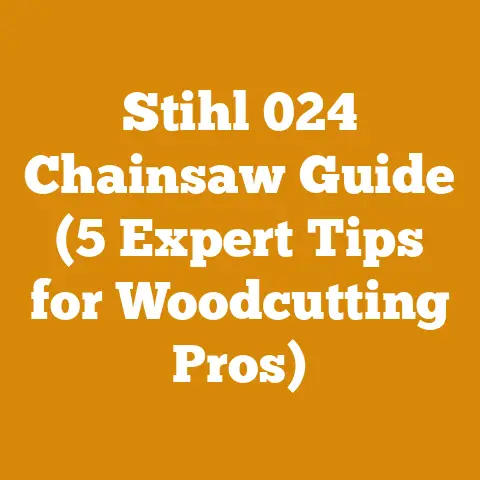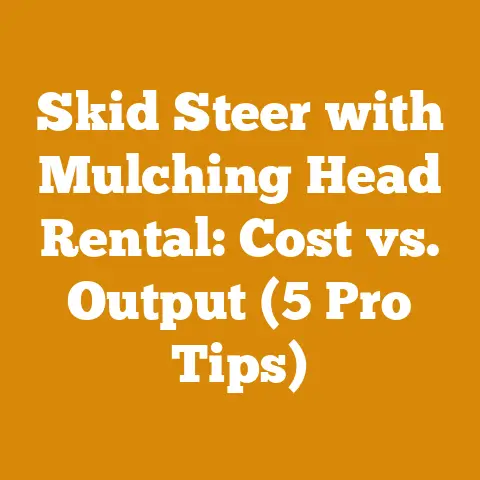Husqvarna 350 Replacement Chain Guide (5 Expert Tips)
Finding Value in Your Chainsaw: A Guide to Husqvarna 350 Replacement Chain Guides and Budgeting for Wood Processing
Let’s talk about chainsaws, specifically the Husqvarna 350. It’s a workhorse, a reliable companion in the woods, and a tool that holds its value surprisingly well. But before we dive into replacement chain guides and expert tips, let’s consider something crucial: the resale value of your Husqvarna 350.
I’ve seen well-maintained Husqvarna 350s fetch a good price on the used market, often exceeding what you might expect for a saw of its age. Why? Because they’re known for their reliability and power. A key part of maintaining that value is ensuring all components are in good working order, including the chain guide. A worn or damaged chain guide not only impacts performance but also signals to potential buyers that the saw hasn’t been properly cared for.
So, keeping your saw in tip-top shape is not just about cutting wood, it’s about protecting your investment. Now, let’s dig into Husqvarna 350 replacement chain guides, expert tips, and, of course, the costs involved in keeping your wood processing operation running smoothly. I’ll share my experiences, data-driven insights, and practical advice to help you make informed decisions and budget effectively.
The Importance of a Healthy Chain Guide: More Than Just a Piece of Metal
The chain guide, sometimes called the chain bar or guide bar, is more than just a piece of metal that holds your chain. It’s the foundation for accurate and efficient cutting. A worn or damaged chain guide can lead to several problems:
- Reduced Cutting Efficiency: A damaged guide bar can cause the chain to bind or vibrate, reducing cutting speed and increasing the effort required.
- Increased Chain Wear: A misaligned or worn guide bar can cause uneven wear on the chain, shortening its lifespan and increasing replacement costs.
- Safety Hazards: A severely damaged guide bar can cause the chain to derail or even break, posing a serious safety risk.
- Damage to the Chainsaw: Excessive vibration and stress from a bad guide bar can damage other components of the chainsaw, leading to costly repairs.
I’ve personally experienced the frustration of working with a damaged chain guide. The saw felt sluggish, the chain kept binding, and the cuts were uneven. It was a recipe for wasted time, wasted energy, and potentially a dangerous situation. Replacing the guide bar immediately improved the saw’s performance and restored my confidence in its safety.
Identifying When Your Chain Guide Needs Replacing
Knowing when to replace your chain guide is crucial. Here are some telltale signs:
- Visible Wear: Look for grooves, burrs, or uneven wear along the rails of the guide bar.
- Difficulty Maintaining Chain Tension: If you’re constantly adjusting the chain tension, it could be a sign that the guide bar is worn or damaged.
- Uneven Cutting: If your cuts are consistently crooked or uneven, the guide bar may be misaligned or bent.
- Excessive Vibration: Excessive vibration while cutting can indicate a problem with the guide bar or chain.
- Damage: Obvious signs of damage like bends, cracks, or deep scratches warrant immediate replacement.
Regular inspection of your chain guide is a simple but effective way to prevent problems and extend the life of your chainsaw. I make it a habit to check my guide bar every time I sharpen the chain.
Expert Tips for Choosing the Right Husqvarna 350 Replacement Chain Guide
Choosing the right replacement chain guide for your Husqvarna 350 is essential for optimal performance and safety. Here are five expert tips to guide you:
1. Match the Specifications
The most important factor is to match the specifications of the original guide bar. This includes:
- Length: The length of the guide bar determines the maximum cutting diameter. Husqvarna 350s typically use guide bars ranging from 16 to 18 inches.
- Gauge: The gauge refers to the thickness of the drive links on the chain. Husqvarna 350s typically use a 0.050″ gauge chain.
- Pitch: The pitch is the distance between the drive links on the chain. Husqvarna 350s typically use a 3/8″ pitch chain.
- Mounting Pattern: The mounting pattern refers to the shape and size of the slot that attaches the guide bar to the chainsaw.
Using a guide bar with the wrong specifications can damage the chainsaw, reduce cutting efficiency, and create a safety hazard. Always consult the owner’s manual or a qualified chainsaw technician to ensure you’re using the correct guide bar.
2. Consider the Type of Guide Bar
There are several types of guide bars available, each with its own advantages and disadvantages:
- Laminated Guide Bars: These are the most common type of guide bar. They consist of multiple layers of steel laminated together. Laminated guide bars are relatively inexpensive and durable, making them a good choice for general-purpose use.
- Solid Guide Bars: These are made from a single piece of steel. Solid guide bars are more rigid and durable than laminated guide bars, making them a good choice for heavy-duty use.
- Sprocket-Nose Guide Bars: These have a small sprocket at the tip of the guide bar. Sprocket-nose guide bars reduce friction and improve cutting speed, making them a good choice for felling large trees.
For most Husqvarna 350 users, a laminated guide bar is sufficient. However, if you’re frequently cutting large trees or using the saw for heavy-duty tasks, a solid or sprocket-nose guide bar may be a better choice.
3. Choose a Reputable Brand
Choosing a reputable brand is essential for ensuring quality and durability. Husqvarna, Oregon, and Stihl are all well-known brands that produce high-quality guide bars.
While cheaper, generic guide bars may be tempting, they often lack the quality and durability of name-brand products. Investing in a quality guide bar will save you money in the long run by reducing the need for frequent replacements.
I’ve personally had good experiences with both Husqvarna and Oregon guide bars. They’re both well-made and durable, and they offer a good balance of performance and value.
4. Look for Features That Enhance Performance
Some guide bars have features that enhance performance, such as:
- Lubri-Dam: This feature helps to keep the chain lubricated, reducing friction and wear.
- Inertia-X: This feature reduces the weight of the guide bar, making it easier to handle the chainsaw.
- Laser Etching: This feature provides clear and accurate markings for chain tensioning.
These features can improve cutting performance and make the chainsaw easier to use. However, they also add to the cost of the guide bar. Consider whether these features are worth the extra expense based on your specific needs and budget.
5. Read Reviews and Seek Recommendations
Before purchasing a replacement chain guide, take the time to read reviews and seek recommendations from other users. Online forums and review websites can provide valuable insights into the performance and durability of different guide bars.
Talking to experienced chainsaw users can also be helpful. They can offer advice based on their own experiences and help you choose the right guide bar for your needs.
I always check online reviews before buying any new chainsaw equipment. It’s a great way to get a sense of the product’s quality and performance from other users.
Understanding the Costs: Replacement Chain Guides and Beyond
Now, let’s get down to the nitty-gritty: the costs involved in replacing your Husqvarna 350 chain guide and maintaining your chainsaw. This is where things can get tricky, as prices can vary significantly depending on the brand, type, and location.
Cost of a Husqvarna 350 Replacement Chain Guide
The cost of a Husqvarna 350 replacement chain guide typically ranges from $25 to $75 USD. This range reflects the different types of guide bars available (laminated vs. solid), the brand (Husqvarna vs. aftermarket), and the length of the guide bar.
Here’s a breakdown of typical price ranges:
- Laminated Guide Bars (Aftermarket): $25 – $40 USD
- Laminated Guide Bars (Husqvarna): $35 – $50 USD
- Solid Guide Bars (Aftermarket): $40 – $60 USD
- Solid Guide Bars (Husqvarna): $50 – $75 USD
These prices are estimates and may vary depending on your location and the retailer. I recommend checking prices at several different retailers before making a purchase.
Additional Costs to Consider
Replacing the chain guide is just one piece of the puzzle. You also need to factor in the cost of other related items:
- Chains: A new chain is often recommended when replacing the guide bar. The cost of a Husqvarna 350 chain typically ranges from $20 to $40 USD.
- Chain Oil: Chain oil is essential for lubricating the chain and guide bar. A gallon of chain oil typically costs $10 to $20 USD.
- Sharpening Tools: Maintaining a sharp chain is crucial for efficient cutting and safety. A chainsaw sharpening kit typically costs $20 to $50 USD.
- Labor Costs (If Applicable): If you’re not comfortable replacing the chain guide yourself, you’ll need to pay a qualified chainsaw technician. Labor costs typically range from $50 to $100 USD per hour.
Budgeting for Wood Processing: A Holistic Approach
Replacing the chain guide is just one aspect of budgeting for wood processing. To get a complete picture of your costs, you need to consider all the factors involved, from timber acquisition to firewood delivery.
1. Timber Acquisition Costs
- Standing Timber: If you’re harvesting your own timber, you’ll need to factor in the cost of purchasing the trees. Timber prices vary depending on the species, size, and quality of the trees. According to the USDA Forest Service, the average stumpage price (the price paid for standing timber) for hardwood sawtimber in the Eastern United States in 2023 was around $200 to $400 per thousand board feet (MBF). However, prices can range from $50 to $1000 per MBF depending on the species and location.
- Logs: If you’re purchasing logs, prices will vary depending on the species, size, and quality of the logs. The average price for hardwood logs delivered to a sawmill in the Eastern United States in 2023 was around $400 to $800 per MBF. Again, prices can vary significantly depending on the species and location.
- Firewood: If you’re purchasing firewood, prices typically range from $150 to $400 per cord, depending on the species, dryness, and location. According to the U.S. Energy Information Administration, the average price of residential firewood in the United States in 2023 was around $250 per cord.
2. Labor Costs
- Logging Crew: If you’re hiring a logging crew to harvest timber, labor costs can be a significant expense. Logging crews typically charge by the hour or by the MBF. Hourly rates typically range from $50 to $150 per hour per crew member.
- Firewood Handlers: If you’re hiring someone to help you process firewood, labor costs will depend on the hourly rate and the number of hours worked. Minimum wage laws vary by state and country, but you should expect to pay at least the minimum wage for labor.
I’ve found that paying a fair wage to my helpers is not just ethical, it also leads to better performance and a more enjoyable work environment.
3. Tool Costs
- Chainsaw: The cost of a chainsaw can range from $200 to $2000 USD, depending on the size, power, and features.
- Log Splitter: The cost of a log splitter can range from $500 to $5000 USD, depending on the size, power, and type (manual, electric, gas).
- Safety Gear: Safety gear, including a helmet, eye protection, hearing protection, and chaps, is essential for safe wood processing. The cost of safety gear typically ranges from $100 to $300 USD.
- Maintenance: Regular maintenance, including sharpening the chain, cleaning the chainsaw, and replacing worn parts, is essential for keeping your tools in good working order. Budgeting for maintenance can save you money in the long run by preventing costly repairs.
4. Permits and Licenses
- Logging Permits: In some areas, you may need a permit to harvest timber. The cost of a logging permit varies depending on the location and the size of the harvest.
- Firewood Permits: In some areas, you may need a permit to sell firewood. The cost of a firewood permit varies depending on the location and the amount of firewood you’re selling.
5. Transportation Costs
- Fuel: Fuel costs can be a significant expense, especially if you’re hauling timber or firewood over long distances.
- Truck Maintenance: Maintaining your truck or trailer is essential for safe and reliable transportation. Budgeting for truck maintenance can save you money in the long run by preventing breakdowns.
6. Drying Costs
- Time: Drying firewood takes time, and time is money. The longer it takes to dry the firewood, the longer it takes to sell it.
- Storage Space: Drying firewood requires storage space. If you don’t have enough storage space, you may need to rent a storage unit.
I remember one year when I underestimated the drying time for my firewood. I ended up having to store it for an extra season, which significantly impacted my profits.
Cost Optimization and Budget Management
Here are some practical tips for cost optimization and budget management in wood processing or firewood preparation projects:
- Shop Around: Compare prices from different suppliers before making a purchase.
- Buy in Bulk: Buying in bulk can often save you money on timber, logs, and firewood.
- Maintain Your Tools: Regular maintenance can extend the life of your tools and prevent costly repairs.
- Use Your Resources Wisely: Avoid wasting timber or firewood.
- Dry Your Firewood Properly: Proper drying can reduce drying time and improve the quality of your firewood.
- Track Your Expenses: Keeping track of your expenses can help you identify areas where you can save money.
- Set Realistic Goals: Setting realistic goals can help you stay on track and avoid overspending.
Calculating Volume: Board Feet and Cords
Understanding how to calculate volume is essential for budgeting and pricing wood products.
-
Board Feet: A board foot is a unit of volume equal to 144 cubic inches. It is commonly used to measure the volume of lumber. To calculate the number of board feet in a log, you can use the following formula:
Board Feet = (Diameter in inches - 4) * (Diameter in inches - 4) * (Length in feet) / 16 -
Cords: A cord is a unit of volume equal to 128 cubic feet. It is commonly used to measure the volume of firewood. A standard cord is typically stacked 4 feet high, 4 feet wide, and 8 feet long.
To estimate the number of cords in a pile of firewood, you can use the following formula:
Cords = (Length in feet * Width in feet * Height in feet) / 128
These calculations are essential for determining the value of timber, logs, and firewood.
Drying Time Estimation
The drying time for firewood depends on several factors, including the species of wood, the size of the pieces, and the climate. Generally, hardwoods take longer to dry than softwoods.
Here’s a general guideline for drying times:
- Softwoods: 6-12 months
- Hardwoods: 12-24 months
You can speed up the drying process by splitting the wood into smaller pieces, stacking it in a well-ventilated area, and covering it to protect it from rain and snow.
I use a moisture meter to check the moisture content of my firewood before selling it. The ideal moisture content for firewood is below 20%.
Actionable Takeaways and Next Steps
Budgeting for wood processing and firewood preparation can be complex, but by understanding the costs involved and implementing cost optimization strategies, you can improve your profitability and ensure the long-term sustainability of your operation.
Here are some actionable takeaways and next steps:
- Assess Your Needs: Determine your specific needs and budget before purchasing any equipment or materials.
- Shop Around: Compare prices from different suppliers to find the best deals.
- Maintain Your Tools: Regular maintenance can extend the life of your tools and prevent costly repairs.
- Track Your Expenses: Keeping track of your expenses can help you identify areas where you can save money.
- Seek Expert Advice: Don’t hesitate to seek advice from experienced wood processors or firewood suppliers.
Remember, a well-maintained Husqvarna 350, along with a solid understanding of budgeting and cost management, is your key to success in the world of wood processing. Keep your chain guide sharp, your budget tight, and your saw running smoothly!






